Authentic Zakuski Recipe Russia, Europe
JUMP TO RECIPEWe strongly advise you to read the cooking tips before jumping to the recipe though
Introduction & history
The French have hors d’oeuvres, the Spanish have tapas, and the Russians take pride in their zakuski — a wide range of appetizers served before every traditional lunch or dinner, and paired with shots of vodka. Typically, zakuski can be served on a table with guests sitting around it, or presented as a buffet, depending on the occasion. There is no set rules on what zakuski should contain — most commonly, Russian hosts will bring everything they have to the table. Bread — white, rye or a mixture of rye and wheat — is most commonly served fresh, or toasted and paired with butter. Then, there is an assortment of cheeses and charcuterie – cold cuts, hams, chicken rolls, liver and tongue pâtés and aspics. Fish is usually served cured or brined, and often includes herring, salmon, eel, and fresh caviar. Dumplings, pancakes and savory pies — such as pelmeni, pirozhki, pampushki, kulebyaka and ... Read more
Pair with
Cooking tips
-
caviar
The most expensive and the most lavish part of zakuski is the caviar — fish roe, or fish eggs. The best caviar comes from the beluga sturgeon and is known as beluga caviar, but osetra and sevruga are also highly appreciated. The eggs are small and grayish-black, and often lightly salted. Salmon caviar, on the other hand, is slightly larger, reddish in color and less expensive. Caviar is typically ... Read more -
salads
Mixed and layered salads, often garnished with sour cream and/or mayonnaise, are another essential part of the zakuski course. Salad Olivier is a classic mixed salad made with chicken, pickles, hard-boiled eggs, peas, onions, and mayonnaise. An example of a layered salad is shuba salad, a combination of herring, grated potatoes, carrots, onions, beets, and mayonnaise, also known as herring under a ... Read more -
bread
Fresh bread — white, rye, or wheat and rye — is served on zakuski table cut in slices or as a part of canapé sandwiches. Sometimes, the bread can be toasted and served with butter on the side. -
aspics
Meat or fish aspics are often made with vegetables such as carrots, peas, and onions, and served either as individual portions or cut in slices. Since the preparation is lengthy — 4 to 6 hours of cooking, plus an additional 2 to 12 hours for cooling, they are usually prepared a day or two in advance.
Recipe variations
Russian Pelmeni
PREP 1h 30min
COOK 10min
READY IN 1h 40min
Adapted from Gastronom.ru, this recipe will yield 60-70 pieces of pelmeni, traditional Russian dumplings filled with minced meat. Serve them with sour cream sauce, or with oil and vinegar dressing.
Ingredients
Russian Pelmeni
1 egg
1 cup ice-cold water
1 pinch salt
600 g wheat flour
FOR THE FILLING
250 g minced beef
250 g minced pork
1 large onion
1 clove garlic
salt
black pepper
Preparation
Russian Pelmeni
Sift the flour onto a working surface. Make a well in the middle and add egg, 1 tbsp water, and a pinch of salt.
Mix together, adding water gradually, until all the ingredients combine. Knead the dough for about 10 minutes, until it becomes homogenous and elastic.
Cover the dough with a damp towel and leave it to rest for 30 minutes.
Meanwhile, prepare the filling. Peel and finely chop the onions and garlic. Mix them with minced beef and pork, salt, and pepper. Combine.
Divide the dough into 4 pieces. Place the first piece on the working board, and cover the rest with a damp towel. Roll the dough into 2 cm thick ropes, then cut each rope into small, 1,5-cm pieces, similar to gnocchi.
Roll out each piece into a flat circle. Place a small amount of filling into the middle, then fold the circle in half, so it forms a crescent. Press the ends with your fingers, so they stick together, or use a fork.
If you are making pelmeni in advance, place them on a tray or platter, sprinkle with flour and put them in a freezer. If you wish to cook them right away, skip this step.
Boil the pelmeni in small batches in slightly salted water. When they start floating on the surface, take them out using a slotted spoon. Serve with sour cream, oil, or vinegar.
Other Variations
Other authentic recipes
















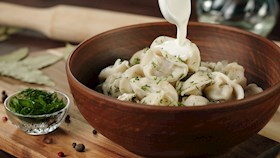

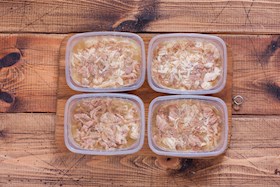
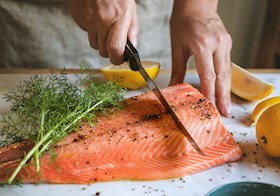
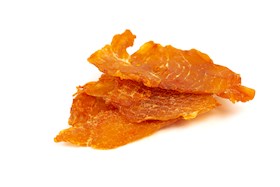
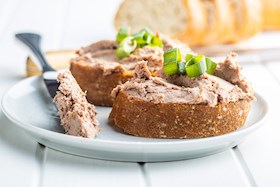

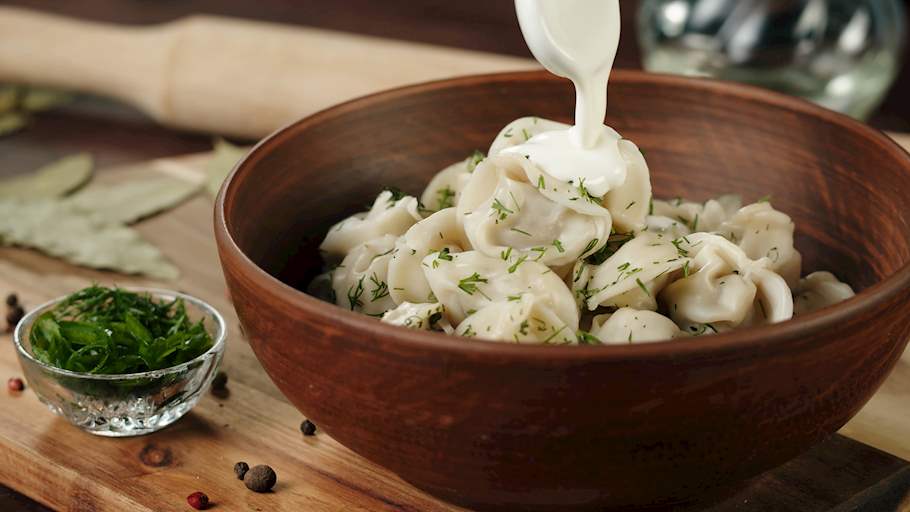
Rating And Comments
Rate It
Wanna try?
Add To List